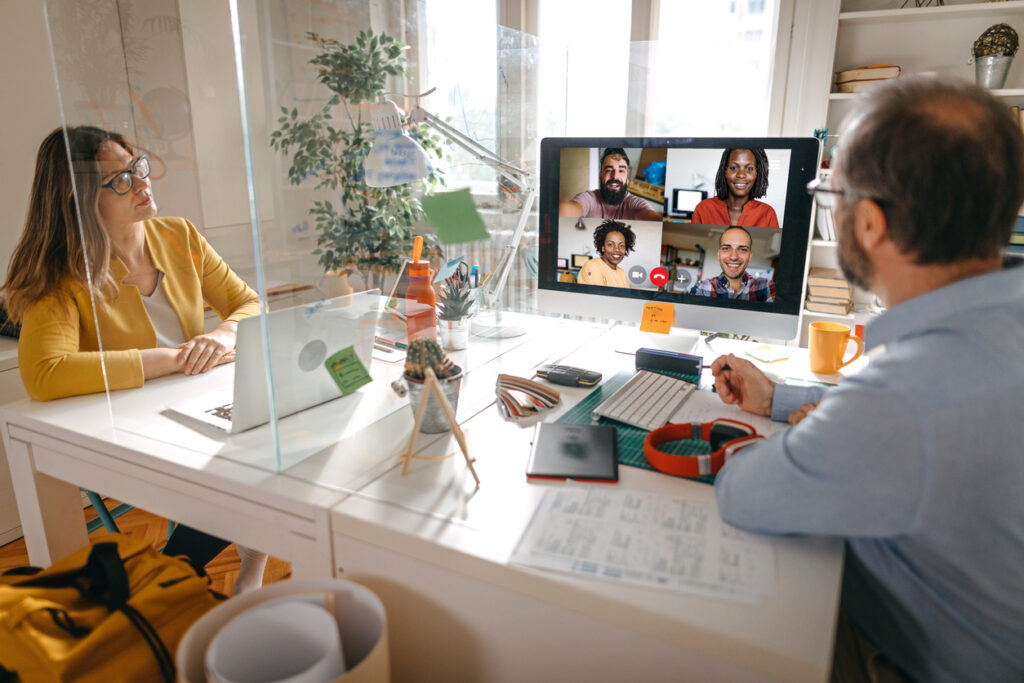We know that how and where we work has fundamentally shifted since the pandemic. Come September, or perhaps even sooner, many will be returning to the workplace for at least part of the week. Many companies have gone further than this and are allowing employees to work remotely or in the office as and when they wish. We haven’t ever worked like this before. It will bring its own challenges, not least to how we learn, collaborate and share knowledge.
Just as we’ve adapted training to a virtual environment, we now need to adapt again to fit a range of learning needs.
So how is this going to work best in a hybrid working environment? Soft skills are strengthened best through collaboration, creativity and experiential learning – all of which are harder to replicate online and possibly even more challenging if some learners are in the office and others accessing the same training and learning online. Learner journeys will need to be aligned to the digital environment people have become used to in the last year and enhance that with valuable experiences and human touchpoints that occur in person.
Five core skills for hybrid learning
Perhaps we need to think again – work will no longer be about where you go and much more about what you do. Under a hybrid model, managers need to understand which type of work is more effective – at home (individual, transactional) or in the office (collaborative, innovative) – and then build systems that play to the strengths of each.
It will be the same with social learning and knowledge sharing. Blended learning, where there is a mix of input face-to-face and online, can work well here but gets really complicated if not everyone is in the office at the same time. The reality is that we may well be catering for both.
Hybrid learning is a learning method where some participants are physically present in a shared space, while others join virtually at the same time. Hybrid learning is not a new practice – how can we make it work well for developing soft skills? Let’s look at some of the top soft skills we actually need first because those too, will change if we are working differently:
- Adaptability: we have been strengthening this skill throughout the pandemic but it’s going to be even more important going forward into a new and uncertain future with many new opportunities but also challenges.
- Resilience: starting with self-awareness and wellbeing, as well as building strong support networks, learning from risks and taking yet more risks.
- Focus: our ability to manage distractions is our greatest barrier to focusing and we are getting worse at it. Focus and presence is what we need, however, to show up with strength and gravitas, whether we are presenting or running a hybrid meeting.
- Communication: our communication skills need to be exceptional in a hybrid working environment where it is easier to create misunderstanding, believe the assumptions we might be making and harder to support others and be truly collaborative and creative.
- Teamwork: traditional team culture has been eradicated during the pandemic and will need to be rebuilt. In a hybrid working environment, having strong team work skills will help to cement a new team structure and enable team members to work effectively together.
Four ways to sharpen skills
Now for the practical – how do we best facilitate and run hybrid training to strengthen these kinds of skills?
- Think of the people joining remotely first
Organise everything you are doing so that they are the top of your thinking, rather than the other way round. Plan all collaborative work like brainstorming, answering questions, and submitting tasks to be done digitally – whether people are in the classroom or joining remotely. All participants can use their phones or laptops and work within the same online platform. Besides the live sessions, planning ongoing asynchronous activities that are integrated into participants’ day-to-day work is crucial for the learning to stick.
- Pair up with another facilitator
You may be facilitating large groups in a hybrid learning environment – this is where having two facilitators can be very beneficial. One facilitator can take the lead with the in-person participants, and another can focus on the remote participants. This way, both learning groups will receive the needed guidance and get timely answers to their questions. Having two facilitators is not meant to divide in-person and remote groups, but rather ensure they have a shared learning experience and feel equally supported.
- Rethink face-to-face learning methods
Don’t be afraid to let go of content that worked for exclusively in-person sessions, but that doesn’t serve learners in a hybrid environment. For example, you might have previously run full day training programmes in person – could this be done differently? For example, you might choose to take both a blended and hybrid approach, spacing out your training over time so you can make a bigger impact on learning outcomes and create post-session sustainability.
- Facilitate separate in-person and virtual breakout groups
Group work is key to engaging people; you don’t need to drop it in the hybrid environment. For synchronous breakout sessions, having separate groups for remote and in-person participants will make things a lot easier. Both groups can record learning points within the same online platform. You can also mix the groups and have remote participants join in a smaller group session via a video call.
Just as we’ve adapted training to a virtual environment, we now need to adapt again to fit a range of learning needs with content that works for face-to-face, blended and hybrid input, and possibly even all three in the same programme.
Interested in this topic? Read How to adapt your virtual learning strategy for a hybrid working future.
We know that how and where we work has fundamentally shifted since the pandemic. Come September, or perhaps even sooner, many will be returning to the workplace for at least part of the week. Many companies have gone further than this and are allowing employees to work remotely or in the office as and when they wish. We haven’t ever worked like this before. It will bring its own challenges, not least to how we learn, collaborate and share knowledge.
Just as we’ve adapted training to a virtual environment, we now need to adapt again to fit a range of learning needs.
So how is this going to work best in a hybrid working environment? Soft skills are strengthened best through collaboration, creativity and experiential learning – all of which are harder to replicate online and possibly even more challenging if some learners are in the office and others accessing the same training and learning online. Learner journeys will need to be aligned to the digital environment people have become used to in the last year and enhance that with valuable experiences and human touchpoints that occur in person.
Five core skills for hybrid learning
Perhaps we need to think again – work will no longer be about where you go and much more about what you do. Under a hybrid model, managers need to understand which type of work is more effective – at home (individual, transactional) or in the office (collaborative, innovative) – and then build systems that play to the strengths of each.
It will be the same with social learning and knowledge sharing. Blended learning, where there is a mix of input face-to-face and online, can work well here but gets really complicated if not everyone is in the office at the same time. The reality is that we may well be catering for both.
Hybrid learning is a learning method where some participants are physically present in a shared space, while others join virtually at the same time. Hybrid learning is not a new practice – how can we make it work well for developing soft skills? Let’s look at some of the top soft skills we actually need first because those too, will change if we are working differently:
- Adaptability: we have been strengthening this skill throughout the pandemic but it’s going to be even more important going forward into a new and uncertain future with many new opportunities but also challenges.
- Resilience: starting with self-awareness and wellbeing, as well as building strong support networks, learning from risks and taking yet more risks.
- Focus: our ability to manage distractions is our greatest barrier to focusing and we are getting worse at it. Focus and presence is what we need, however, to show up with strength and gravitas, whether we are presenting or running a hybrid meeting.
- Communication: our communication skills need to be exceptional in a hybrid working environment where it is easier to create misunderstanding, believe the assumptions we might be making and harder to support others and be truly collaborative and creative.
- Teamwork: traditional team culture has been eradicated during the pandemic and will need to be rebuilt. In a hybrid working environment, having strong team work skills will help to cement a new team structure and enable team members to work effectively together.
Four ways to sharpen skills
Now for the practical – how do we best facilitate and run hybrid training to strengthen these kinds of skills?
- Think of the people joining remotely first
Organise everything you are doing so that they are the top of your thinking, rather than the other way round. Plan all collaborative work like brainstorming, answering questions, and submitting tasks to be done digitally – whether people are in the classroom or joining remotely. All participants can use their phones or laptops and work within the same online platform. Besides the live sessions, planning ongoing asynchronous activities that are integrated into participants’ day-to-day work is crucial for the learning to stick.
- Pair up with another facilitator
You may be facilitating large groups in a hybrid learning environment – this is where having two facilitators can be very beneficial. One facilitator can take the lead with the in-person participants, and another can focus on the remote participants. This way, both learning groups will receive the needed guidance and get timely answers to their questions. Having two facilitators is not meant to divide in-person and remote groups, but rather ensure they have a shared learning experience and feel equally supported.
- Rethink face-to-face learning methods
Don’t be afraid to let go of content that worked for exclusively in-person sessions, but that doesn’t serve learners in a hybrid environment. For example, you might have previously run full day training programmes in person – could this be done differently? For example, you might choose to take both a blended and hybrid approach, spacing out your training over time so you can make a bigger impact on learning outcomes and create post-session sustainability.
- Facilitate separate in-person and virtual breakout groups
Group work is key to engaging people; you don’t need to drop it in the hybrid environment. For synchronous breakout sessions, having separate groups for remote and in-person participants will make things a lot easier. Both groups can record learning points within the same online platform. You can also mix the groups and have remote participants join in a smaller group session via a video call.
Just as we’ve adapted training to a virtual environment, we now need to adapt again to fit a range of learning needs with content that works for face-to-face, blended and hybrid input, and possibly even all three in the same programme.
Interested in this topic? Read How to adapt your virtual learning strategy for a hybrid working future.






